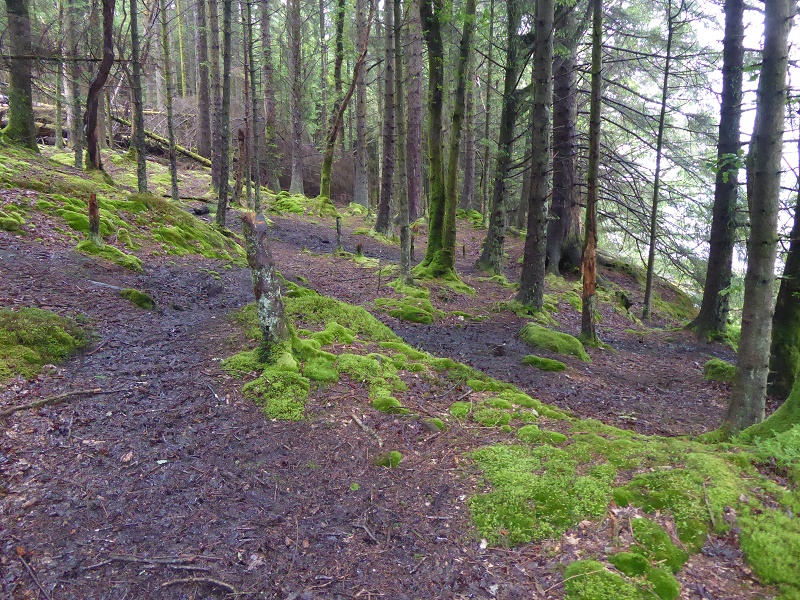
In a news release yesterday (see here) the Loch Lomond and Trossachs National Park Authority claimed to have reflected on the first four months of the camping byelaws. The Park used a survey, which purportedly shows positive feedback from people booking permits and unsubstantiated claims from the Chair of St Fillans Community Council about the difference the byelaws had made, to conceal the key announcement: the Park has in effect ceased trying to apply the camping byelaws to campervans and caravans.
So, if you are in a campervan or caravan you need no longer fear prosecution and a criminal record if you stop overnight on the loch shores unlike people staying in tents. This raises some fundamental issues about the justification for the byelaws: if there is no longer any need to limit the numbers of campervans, what is the justification for limiting numbers of campers?
The camping byelaws and vehicles
When announcing the Minister’s approval of the camping byelaws on 26/1/16the LLTNPA news release stated: “They will also prevent inappropriate use of public laybys as encampments by caravans and campervans”. This turns out to have been a lie. A number of us had tried to advise the LLTNPA that one of the many reasons byelaws were not needed was that encampments could be dealt with under existing laws. It appears that at long last the Park agrees: “Police Scotland will use roads legislation to deal with unlawful encampments and irresponsible use of motor vehicles in laybys.”
I had wondered why the Your Park Report (see here) to the Loch Lomond and Trossachs National Park Authority Board on 19th June made not a single mention of campervans and caravans and also why not a single Board Member asked about the serious issues with enforcement raised on parkswatch (see here). The reason I believe is that the LLTNPA had already decided it was unable to enforce the byelaws against caravans and campervans, as predicted on parkswatch, (see here) but did not want this information made public. The news release, in the Park’s usual fashion, is a re-write of history and distorts the truth:
Going back over a number of years, some lochshore laybys have had issues with encampments of motorhomes and caravans creating negative impacts, damaging the environment and preventing access for other visitors. [Comment: preventing encampments was one of the main justifications for the byelaws even though powers already existing to deal with this e.g under the Criminal Justice and Public Order Act]
Ongoing discussions on how best to manage these issues have agreed that Police Scotland will use roads legislation to deal with unlawful encampments and irresponsible use of motor vehicles in laybys. People with campervans and motorhomes can use lochshore laybys to stop and rest (including sleeping overnight if necessary),[Comment: and, if they want to] but encampment on a road (including laybys) is an offence under road traffic legislation and will be managed by Police Scotland accordingly, in cooperation with land owners. Camping permit areas for tents adjacent to some lochshore laybys are unaffected. [Comment: having resolved the anomaly where the LLTNPA were allowing caravans to stop for free but requiring permits from campervans both can now stop for free and sit inside away from the midges watching poor campers who are charged for the privilege].
As a result the National Park Authority will no longer provide permits for motorhomes to stay in laybys but will focus on continuing to provide great locations for overnight motorhome stays at key off-road visitor areas around the National Park. [Comment: the LLTNPA website now says these are Three Lochs Forest Drive, Inveruglas and Firkin Point].
The news release raises a number of further questions:
- Who decided that the byelaws and permit system would no longer be applied to campervans in laybys (by the way if you have been charged for the privilege, ask for your money back)? Surely such an important decision should have been taken by the Board at their meeting on Monday 19th June. Did the Board take this decision in secret or has it been decided by staff?
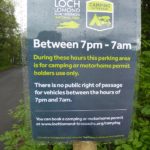 What power does the Park have to remove vehicular rights of passage between 7am and 7pm from places like Inveruglas and Firkin Point? If the LLTNPA don’t have the power to remove vehicular rights of passage, caravans and campervans can still spend the night on the roads to these places without purchasing a permit. This is because under the byelaws its not an offence to sleep overnight in a vehicle on a road (public or private) and the legal definition of a road of course includes verges as well as laybys). It appears the Park is still trying to enforce charges for campervans in three places contrary to the Road Traffic Act.
What power does the Park have to remove vehicular rights of passage between 7am and 7pm from places like Inveruglas and Firkin Point? If the LLTNPA don’t have the power to remove vehicular rights of passage, caravans and campervans can still spend the night on the roads to these places without purchasing a permit. This is because under the byelaws its not an offence to sleep overnight in a vehicle on a road (public or private) and the legal definition of a road of course includes verges as well as laybys). It appears the Park is still trying to enforce charges for campervans in three places contrary to the Road Traffic Act.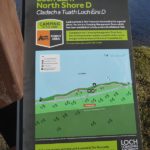 How much money has the Park wasted on trying to prevent campervans exercising their legal right to spend the night on part of the road network (eg printed information, the signs in laybys stating motorhomes required a permit, legal advice, the motorhome terms and conditions)? According to the management accounts at the Board Meeting expenditure on signage for the byelaws in 2016-17 was £154,095 (original budget £100,000).
How much money has the Park wasted on trying to prevent campervans exercising their legal right to spend the night on part of the road network (eg printed information, the signs in laybys stating motorhomes required a permit, legal advice, the motorhome terms and conditions)? According to the management accounts at the Board Meeting expenditure on signage for the byelaws in 2016-17 was £154,095 (original budget £100,000).
The News Release does not go as far as saying that the LLTNPA will never enforce the camping byelaws against campervanners or caravans (its focus is on laybys) because if it did so, I suspect campers could challenge the Park in Court for selective application of the byelaws. (This is what I had asked to speak to the Board about on 19th June (see here) but agreed to defer pending a meeting with the Convenor James Stuart). Despite this, I believe the camping byelaws are dead in the water as far as campervans and caravans are concerned. The reason for this is that not only did the LLTNPA and Scottish Government fail to consider Road Traffic Legislation when drafting the byelaws, more importantly they failed to consider the people living in caravans in camping management zones who serviced tourist businesses. This, I believe, explains why LLTNPA staff decided not to enforce the byelaws against caravans and, after staff took that decision – what legal right did they have to do this? – attempts to apply the byelaws against campervans was doomed.
The alleged positive feedback from people applying for permits
The LLTNPA news release claim that between 1st March to 26th June 2017 approximately 2270 camping or motorhome permits have been booked, 492 people completed the LLTNPA feedback survey on the permit system and of these 85% would recommend staying in one of the new permit areas and 92% found it easy to buy a permit. The LLTNPA Board was very impressed with this feedback, which was reported to their meeting, commending the high response rate and interpreting the result to mean the byelaws were going very well.
Unfortunately the Board failed to ask some basic questions which are not addressed in either the paper put to them or the news release. The first is about the numbers of people booking permit. As Ramblers Scotland pointed out yestereday on Grough (see here) 2270 permits “equates to a combined total of 19 permits a day for motorhomes and tents” out of over 300 allegedly available. The RA could also have hightlighted that the 2270 permits appears to include both bookings in advance and bookings for the campsites included in the permit system. The total number suggests therefore that either people are deserting the Park in droves or ignoring the permit system. The Park, if it was honest, would have published a comparison with previous numbers of campers recorded on the loch shores. In fact this should be part of the basic data the Park provides as a basis for any future evaluation of the byelaws.
The second question to be asked is about the feedback. The Park needs to explain how 85% of respondents would recommend staying in a permit area when most of the permit areas are uncampable or terrible for camping (see here)or (see here). and no-one in their right mind would recommend them to anybody.

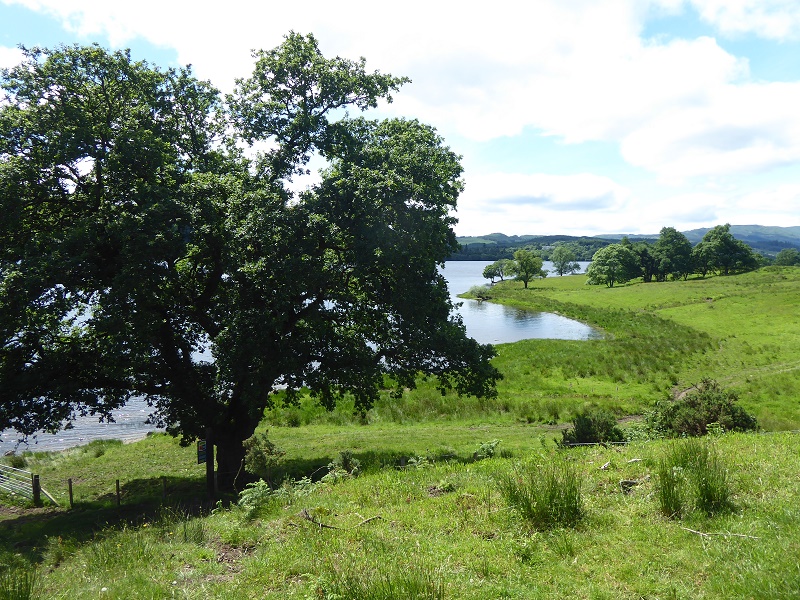
One possible explanation for the majority of permit holders being prepared to recommend permit areas for camping is that people are only booking permits for a small number of the better permit areas. There are a handful:
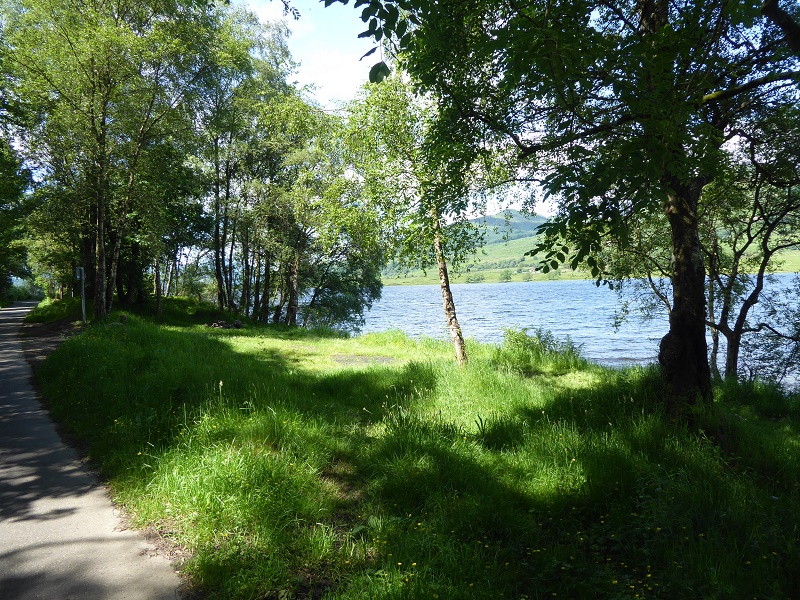
This explanation is more plausible if Sallochy, on the West Highland Way, is as I suspect included in the returns. It alone could probably explain the response. Its in very high demand and provides excellent camping provision. Just what the LLTNPA needs but has failed to deliver elsewhere. Its in the public interest therefore that the LLTNPA should make public its data and in particular the number of feedback surveys completed for each survey area. If it turns out that positive surveys have been completed for some of the very poor permit areas, the Park has some answering to do on just how people could recommend such terrible places for camping. If not, the Park Board should be asking why people are not returning survey forms for those areas.
After visiting the Coilessan permit zone (top photo) a couple of weeks ago I stopped to talked to a Forestry Worker. He agreed the Coilessan zone was a very poor place for camping, told me some people had been camping there and also that they had been very disappointed. I am sure he was right. Why is this sort of information not being fed to the LLTNPA Board?
Quote from Chair of St Fillans Community Council
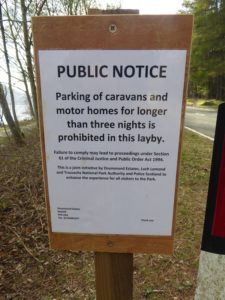
The news release ends with Richard Graham, Chair of St Fillan’s Community Council, “The thing that has struck me most since the byelaws were introduced is the lack of damage, graffiti and litter. These are less evident and it also seems to be less congested.
“People who said they would never come back because of antisocial behaviour are coming back. I speak to fishermen who are delighted with the byelaws because they are experiencing less trouble on Loch Earn.
“Families are also coming back to picnic spots that they had just stopped coming to. In our community we are actively encouraging people to come and enjoy the area so this is amazing to see.”
Ignore the propaganda about families coming back – what about the families who used to camp and still do on the south Loch Earn road? – and the complete lack of evidence for these assertions, the Park (and Mr Graham if he was aware of how his quote would be used) are shameless. Yes, there was a problem on the north Loch Earn road – of encampments (which St Fillans Community Council had rightly complained about for years) – but its action by Drummond Estates that has dealt with this, NOT the byelaws and to claim otherwise is to distort the truth. If it was the byelaws that had made the difference on North Loch Earn, the LLTNPA would hardly now be announcing it was no longer going to enforce them.
What the news release fails to mention
As always with the LLTNPA, what is not said is as significant as what is:
- there is no mention of how many people have been referred to the Procurator Fiscal for breach of the byelaws (by the end of May there has been at least five, at least one of which involved the LLTNPA’s own police officer Paul Barr)
- there is no analysis or attempt to collect feedback from anglers (the group worst affected by the byelaws) and what its like now trying to fish in poor weather or overnight when shelters are banned
- there is no mention that the LLTNPA has decided not to apply the byelaws to Park residents allowing people to camp in their own gardens (though the byelaws made this a criminal offence)
- there is nothing about how much money has been wasted
What next?
I believe this news release is a damage limitation exercise. The Park was losing its reputation and damaging tourism so its abandoned trying to control campervans and appears to be trying to refocus its efforts purely on campers. The unfairness of this is manifest. People who can afford campervans can stop by the roadsides, people who sleep in tents (who tend to be poorer) can’t. Its called social exclusion, its bad for people’s health (being outdoors is a great contributor to good health), its damaging tourism (particularly angling related businesses) and is undermining what were previously world class access rights.
What people who care about access rights need to do now is respond to the National Park Partnership Plan (my next post will be on recreation) and call upon the LLTNPA to conduct a proper review of what remains of the camping byelaws, engaging recreational interests, with a view to developing alternatives. People also need to object most strongly to the LLTNPA’s coded proposals to introduce new visitor management measures, i.e to extend the byelaws, to the Loch Lomond islands.
So when are the signs being removed and are they going to get the kids that put them up to take them down I was at the lade inn car park when they put them up 6 girls from a school in Stirling digging holes
Paul, I never knew this – priceless information! – and the signs still cost over £150K!
Loch Venachar North Shore C permit zone, where there is no access to the shore, how ironic and misleading.
The Park Authority have chosen the camping provision based on the proximity to laybys and one can only assume they have drawn the outline of the permit zone from a satellite image or map as it is inconceivable that anyone actually visited the sites to check if tents could be pitched unless of course they have been chosen on purpose to be the worst available locations to drive customers to commercial sites. So far a number of camping zones have been discontinued only 3 months after creation with considerable sums of money wasted. One case in point is Forest drive Zone ‘L’ where their “park spin” explained they have listened to public concerns and moved the zone to the side of Loch Achray opposite, where in fact they were already allowing people to illegally camp because zone L had none of the claimed 9 camping pitches on the 1st of March. Of course had Park Authority bothered to inspect the sites prior to creating the signs this would not have been necessary now the signs have to be recreated for the new zone L at an unspecified cost with the old ones being scrapped. Forest Drive Zone D and Zone K have also been removed from the booking portal as has Zone N which appeared on maps but never on the ground, Loch Venachar North zone A has also disappeared from the booking portal where an extraordinary 4 signs are fitted. Total money wasted could well be over £5,000 and counting. Then of course this lost provision has to be topped up elsewhere so more new signs need to be created.
The park needs to immediately scrap all camping permit charges, they are failing to provide a decent camping provision in almost all of their newly created zones with only some of the original popular loch shore spots being acceptable. They are failing to provide sufficient parking to service the number of pitches they claim to have supplied, failing to keep the park clean and failing to control antisocial behavior as promised, but in any case that is not what the permit charges are used for. What the park fail to tell us is that the many commercial campsites within the park boundary are also listed on the camping booking system so in fact the permit charges are subsidising the cost of commercial operators using the system. This needs to stop now other wise the park authority need to ante up and provide the services visitors are paying for.